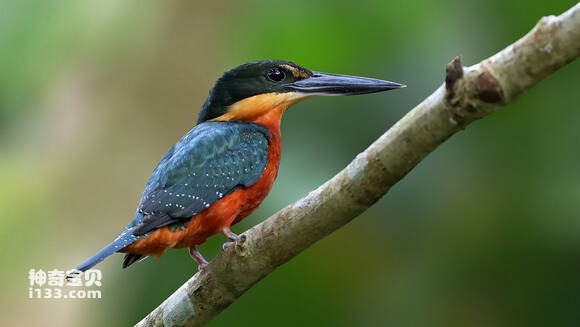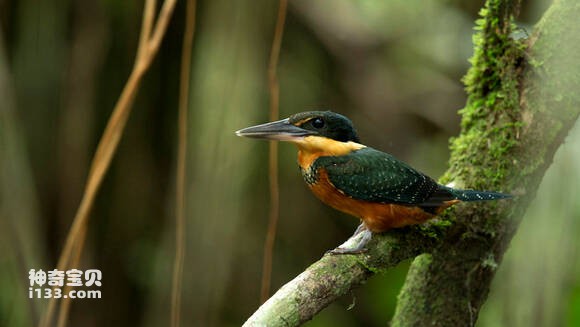Chloroceryle inda
IUCN
LCBasic Information
Scientific classification
- name:Chloroceryle inda
- Scientific Name:Chloroceryle inda,Green-and-rufous Kingfisher
- Outline:Climbing birds
- Family:
Vital signs
- length:About 24 cm
- Weight:46-62g
- lifetime:No textual research information is available
Feature
Distribution and Habitat
It is found in South America (including Colombia, Venezuela, Guyana, Suriname, Ecuador, Peru, Bolivia, Paraguay, Brazil, Chile, Argentina, Uruguay, and the Malvinas Islands (also known as the Falkland Islands))
Brown bellied green fish dogs can reach a height of 400 meters, the distribution is very uneven.
Appearance
The brown belly green fish dog is 24 cm long, the male bird weighs 46-60g, and the female bird weighs 53-62g. The adult male has a dark green forehead and eyes, and a red brow. The neck has a dark green luster. The chin, throat, and whiskers are pale yellow or light yellow, and the sides of the neck are bright red. A thin yellowish collar encircled the neck, and the top of the back was almost black. The rest of the tip has a dark green luster. Covered wing inside white. The primary and secondary wings have four rows of white spots arranged neatly. A few small white spots on the tail. The underbelly is dark red, the wings and undertail slightly pale. Black mouth, yellow jaw. The irises are dark brown and the legs are dark grey. The adult female is different, with green feathers across the chest and a white forehead. The size is larger. Mouth long and flat side, peak ridge round; Nasal sulci was significant; The wingtip of the first primary feather is shorter than that of the second, and
Details
Chloroceryle inda, also known as Green-and-rufous Kingfisher, is a species of kingfisher.

The brown bellies are fish-eating kingfishers with excellent diving skills and can even hover in the air to lock on to their targets. They live mainly by the river and fish for a living. It lives in brush or open forest, clear and slow-flowing rivers, streams, lakes and irrigation canals. It often flies over rivers, streams, ponds and swamps looking down for food. As soon as you spot food, make a quick dive. Usually live alone on the top of a tree branch near the water, the top of a telephone pole or on a rock, waiting for an opportunity to hunt. It usually squatts on the low branches and stones near the water, waiting for bait. The method of hunting is the same as that of the kingfisher, which often preys on the surface of the water or dives into the water to hunt. Sometimes they can even disappear completely under water; Sometimes it flaps its wings and stops flying in the air about 3-10 meters from the water, as if hanging on the water, and when it sees the prey, it immediately dives into the water to hunt it. It puts the catch on the perch, and keeps fiddling with it, and even throws the fish up in order to swallow the fish from the head first. The food is mainly small fish, and eats crustaceans and a variety of aquatic insects and their larvae, but also pecks at small frogs and a few aquatic plants.

The brown-bellies usually nest on earth cliffs, or in the dykes of fields and streams and rivers, and use their mouths to dig tunnelled burrows for nests, which are generally free of bedding. The eggs are laid directly on the nest ground. Each clutch lays 3-5 eggs. Egg color pure white, bright, solid shell, slightly spotted.

Listed in the International Union for Conservation of Nature (IUCN) ver 3.1:2008 Red List of Birds.
Protect wild animals and eliminate wild meat.
Maintaining ecological balance is everyone's responsibility!








